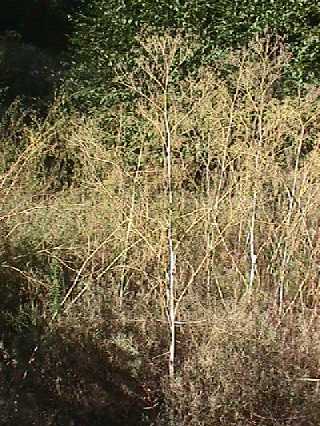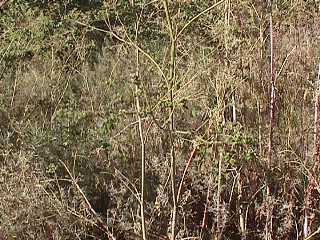

General Species Description
- Tall (0.5-3m), robust, hairless biennial. The stem is hollow, unbranched and purple spotted, growing from a whitish taproot. When crushed has a disagreeable odor.
Leaves
- This species has leaves (15-30 cm long) that are 2x-3x pinnately compound and carrot like. The leaf stalks are sheathing at the base.
Inflorescence/Flowers
- The flowering stems are 3m tall, and only produced the second year. The flowers are white and small in many terminal compound umbels. Flowers from May-August.
Fruits
- Fruits (2-3mm long) egg-shaped and somewhat flat. Have raised wavy ribs.
Habitat
- Grows in moist disturbed sites (such as abandoned fields, ditches or roadsides) at low elevations.
Range
- Occurs in all counties in our area and most of North America. Introduced from Europe.
Similar Species
- Could be confused with other genera of Apiaceae (Cicuta, Angelica, Sium, Conium, and Oenanthe), but Conium is the only one with purple spots and a bad odor when crushed
Ecological Value
- No specific ecological value.
Human Value
- This plant is extremely toxic to humans, and can be fatal if any part of the plant is ingested. Snohomish rubbed their fishing hooks with it to mask their human odor. S'klallam women rubbed it on themselves in order to attract a mate.
References
- Cooke, Sarah. 1997. Wetland Plants of Western Washington and Northwestern Oregon.Seattle Audubon Society, Seattle, Washington.
Gilkry, H.M., L.J. Dennis. 1967. Handbook of Northwestern Plants. Oregon State University Bookstores, Corvalis, Oregon.
Pojar, J, and A. Mckinnon. 1194. Plants of the Pacific Northwest Coast. B.C. Ministry of Forests and Lone Pine Publishing.
This page was created by: Aaron Nepple, August 2000
Return to Northwest Oregon Wetland Plants Project